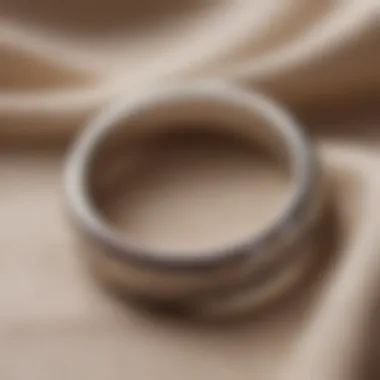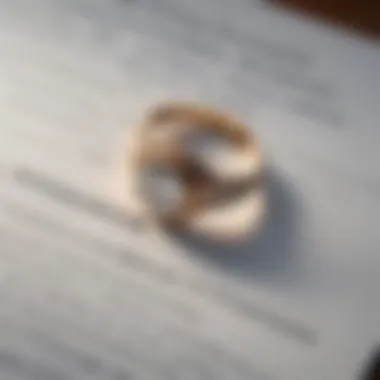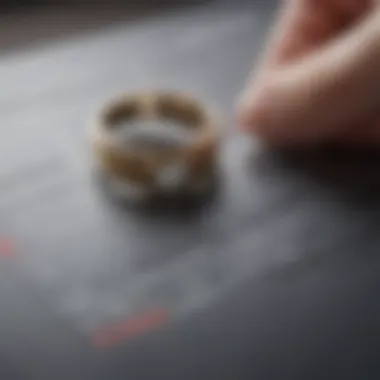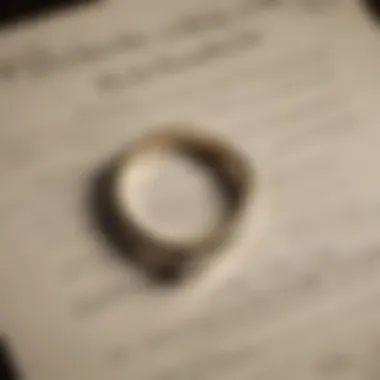Lost Wedding Ring and Home Insurance Coverage Explained


Intro
Losing a wedding ring is not just a matter of monetary value; it strikes at the heart of emotional significance. This seemingly simple piece of jewelry often holds memories, promises, and love. Yet, the unfortunate reality remains: such losses happen more often than one might think. When they do, understanding how home insurance can serve as a safety net becomes paramount.
Home insurance is often seen as a catch-all solution for various calamities, but the specifics around lost jewelry can be murky waters. Many people do not realize that not all policies provide blanket coverage for lost items, especially those that carry deep sentimental value. However, by digging into the nuances of home insurance, individuals can better safeguard their treasured assets, ensuring that an unexpected loss does not translate into a financial setback.
In this guide, we will explore various elements surrounding home insurance coverage in relation to lost wedding rings. The focus will span from policy definitions to practical tips for navigating claims. Let's set sail and see what the world of home insurance can offer regarding lost tokens of love.
Prologue to Jewelry Coverage in Home Insurance
When it comes to home insurance, many people focus solely on protecting their homes from damages, often overlooking the finer details that matter just as much. Jewelry, especially sentimental pieces like wedding rings, represents more than mere material value; they embody memories and emotions that can’t be easily replaced. Understanding how jewelry is covered under home insurance is vital for anyone who wants to ensure that their precious items are protected against theft, loss, or damage.
Significance of Jewelry as Personal Property
Jewelry holds a unique place in our lives, often used to commemorate milestones or significant events. Wedding rings, in particular, are laden with emotional weight, representing love and commitment. This makes them not just personal property but also crucial elements of our identity. Losing a wedding ring can lead to more than just financial loss; it can evoke feelings of anxiety and sadness. By integrating jewelry coverage into home insurance policies, individuals can safeguard against potential heartbreak and financial strain.
Moreover, it's good to acknowledge that jewelry can appreciate in value over time. For example, a simple wedding ring today may be worth a considerably higher amount in the future. This highlights the need for adequate coverage to reflect not only sentimental value but also potential financial worth.
Understanding Home Insurance Basics
To navigate the landscape of home insurance effectively, it’s essential to first grasp what it encompasses. Home insurance is designed to protect against various risks, including damage to the physical structure of a home and loss or theft of personal property.
Typically, there are two primary components in home insurance: structural coverage and personal property coverage. Structural coverage protects the building itself, while personal property coverage covers belongings within the home, including furniture, electronics, and, of course, jewelry.
However, not all home insurance policies are created equal. Coverage limits for jewelry often come with caps—usually around a specific dollar amount—regardless of the actual value of the jewelry. This means that, without additional coverage or riders, a lost wedding ring valued at, say, $5,000 may only be reimbursed for a fraction of that amount under a standard policy. Thus, understanding these nuances is crucial when evaluating how well your existing home insurance fits your needs.
It's also important to keep in mind that specific circumstances can influence coverage, including events like natural disasters or theft. Policies often differ based on the insurer and specific conditions within the policy, so checking the fine print can save you from unexpected surprises down the line.
"Understanding what is covered can make all the difference when you filing a claim. Be proactive about learning your policy, especially when it comes to personal items like jewelry."
Types of Home Insurance Policies
When it comes to protecting your cherished belongings, understanding the types of home insurance policies available is paramount. Different policies offer varied levels of protection for personal belongings, such as jewelry, and they come with their own sets of benefits and considerations. Knowing what each policy entails can help you make well-informed decisions that safeguard your valuables, including the ever-so-important wedding ring.
Standard Homeowners Insurance
Standard homeowners insurance is often the first line of defense for many homeowners. This type of policy generally covers the physical structure of a home and its contents against risks like fire, theft, and vandalism. Regarding personal property, this insurance typically covers jewelry, but there are significant limits. For example, they might set a cap—often around $1,500—for individual jewelry items unless the items are specifically scheduled.
This all means that if your wedding ring gets lost, you might find yourself shortchanged unless you've taken the right steps to secure additional coverage. Reviewing your current policy is crucial, as it may not provide adequate protection for high-value items.
Renters Insurance
For those not owning a home, renters insurance serves as an essential safety net. Just like homeowners insurance, it covers personal possessions against loss or damage due to theft, fire, or certain natural disasters. While this type of coverage can be less expensive than a homeowners policy, it too has limits on jewelry protection. Understanding these limitations is crucial if your wedding ring or other significant jewelry has substantial value. If your ring holds sentimental value or comes with a hefty price tag, consider talking to your insurer about scheduling it for full coverage.
"Most renters policies don't cover theft of jewelry while away from home and often have sub-limits."
Comprehensive Coverage Options
When valuable items are a big concern, comprehensive coverage options become essential. These options can include endorsements or riders, which allow you to add specific coverage for high-value items like jewelry. By scheduling your wedding ring separately, you can often insure it for its full value without the typical caps set by homeowners and renters insurance.


This way, you can rest easy knowing that if something unfortunate happens—like losing your beloved ring—you'll be covered appropriately. It’s worth doing your homework here and discussing your unique needs with an insurance agent, who can inform you about what additional coverage may be available based on your situation.
In summary, understanding the types of home insurance policies and their specific coverages is vital for protecting your personal property, especially valuable items like wedding rings. Knowing your options enables you to create a safety net that caters to your unique circumstances.
Coverage for Lost Wedding Rings
In the realm of home insurance, many individuals overlook the fragile status of their cherished possessions, particularly wedding rings. Understanding how lost wedding rings are covered under your policy is essential for safeguarding their irreplaceable value. With the emotional weight and financial investment attached to such items, it is crucial to know the ins and outs of jewelry coverage. Whether you are a newly married couple or someone who has had a wedding ring passed down through generations, being informed about your policy can mean the difference between peace of mind and a financial headache.
What Does Jewelry Coverage Typically Include?
Most standard home insurance policies provide a degree of coverage for personal property, including jewelry. However, specific details can vary widely. Here are some common inclusions:
- Basic Coverage: Typically, your policy will cover loss or theft of jewelry due to perils listed in your agreement, such as fire, vandalism, and certain types of water damage.
- Value Limitations: Jewelry is often subject to a limit on the total value covered. Most homeowners insurance policies cap coverage for jewelry at around $1,000 to $2,000. This is often not enough for high-value items like wedding rings.
- Accidental Loss: Some policies may also cover accidental loss, which can be a relief in situations where you might misplace your ring.
Important: Be sure to read the fine print of your policy to understand the limits and exclusions clearly. Knowing this could save a lot of heartache later on.
Special Limitations on Jewelry Coverage
Even though home insurance may cover lost wedding rings, there are often critical limitations involved. Being aware of these can help you avoid unexpected surprises when filing a claim:
- Exclusions for Certain Events: Damage or loss from certain events, like floods or earthquakes, may not be covered unless specifically included in your policy.
- Negligence Clause: If the loss occurs due to negligence on your part, like leaving the ring unattended in a public place or not securing it in a safe, you may find your claim denied.
- Age and Condition of the Jewelry: Some companies close the nets on claims for older or heavily worn jewelry, arguing it was not in a reasonable condition.
Scheduled vs. Unscheduled Personal Property
When it comes to insuring valuable items like wedding rings, you have options regarding how to list them on your home insurance policy:
- Unscheduled Personal Property: This category includes jewelry that is part of your general home insurance coverage. While it’s convenient for items of lower value, the limits can leave you vulnerable. In this case, jewelry is covered under the overall personal property limit with restrictions mentioned earlier.
- Scheduled Personal Property: This means specific valuable items, like your wedding ring, are documented and insured for their actual value. With this option, you often do not face the same limitations, such as lower loss limits or deductibles. Listing your items ensures they get an appropriate level of protection. To do this, you would typically need to provide an appraisal to your insurance provider.
Taking the time to consider these distinctions can help you make the most informed choice concerning your jewelry coverage and potentially save you a significant sum should a tragic loss occur.
The Claims Process for Lost Jewelry
Navigating the labyrinth of claims after losing a precious item can feel overwhelming. However, understanding the claims process for lost jewelry is crucial for any homeowner who's concerned about their valuable possessions, such as wedding rings. This section demystifies the steps involved, helping you feel more equipped if faced with needing to file a claim.
Steps to Take After Loss
Upon discovering that your wedding ring is missing, the first instinct often is panic. However, keeping your wits about you is vital. Here’s a structured approach you can take:
- Retrace Your Steps: Think about the last time you saw your ring; maybe it slipped off during a workout or at a friend’s party.
- Document the Circumstances: Write down when and where you last had the ring. This narrative becomes a part of your claim.
- Notify Relevant Parties: If you think it was lost in a public area, inform management or authorities. They might have a lost and found service.
Taking these steps not only can help recover the item but also sets a solid foundation for your claim.
Gathering Necessary Documentation
The beauty of jewelry coverage often lies in its details. Yet, when you lose a wedding ring, you’ll need to gather a few critical documents to support your claim:
- Proof of Purchase: If you still have it, the original sales receipt can be invaluable. It proves the item’s existence and value.
- Photographs of the Ring: Images of your ring can prove its condition and can be helpful in the absence of an appraisal.
- Appraisal Reports: An appraisal is crucial as it establishes current value. If you had one done, make sure to include it with your claim.
By compiling these documents, you create a robust case that helps the claims adjuster make an informed decision.


Filing a Claim: Key Considerations
Now that you have everything ready, it’s time to file your claim. Here are a few considerations that every policyholder should keep in mind:
- Know Your Policy Limits: Most insurance policies have specific limits for jewelry. Be aware of how much coverage your policy offers for lost items to set realistic expectations.
- Claim Process Timeline: Each insurer has its own procedures. Some may want you to file the claim online, while others require a phone call. Investigate the preferred method for your provider.
- Follow Up: After submitting your claim, keep track of it. Don’t shy away from reaching out to your insurance representative for updates—proactive communication can work wonders.
Important: Having a solid understanding of these elements can smoothen the claims process considerably. It lessens stress, allowing you to focus on recovering from the loss rather than getting lost in insurance jargon.
Understanding the claims process for lost jewelry doesn’t just prepare you for a potential loss; it empowers you to make well-informed decisions should the need arise.
Importance of Appraisal and Inventory
In the realm of home insurance, accurately assessing the value of your belongings, especially precious items like wedding rings, cannot be understated. Appraisals and inventories serve as the cornerstone for maximizing coverage benefits and navigating claims processes effectively. Without thorough documentation of your jewelry, what might seem like a routine claim could quickly become a tangled web of confusion and disputes.
Getting a Professional Appraisal
One of the key steps in ensuring you’re well-covered is to obtain a professional appraisal for your wedding ring. It's not just a matter of knowing how much you paid for it or trusting your gut on its worth. A certified appraiser uses expertise to evaluate the quality, materials, and even the craftsmanship involved. You might think, "Aren't just any ol' jeweler good enough?" But the reality is that only a certified professional can provide that official stamp of value needed to substantiate your claim in the unfortunate event of loss.
- Why a Professional Appraisal Matters:
- It provides an unbiased and accurate value.
- Helps identify unique features of the piece, which can affect worth.
- Offers a formal document that can be essential during claims processing.
Having this appraisal done is akin to having a financial safety net. Not only will it give clarity and peace of mind about the actual value of your ring, but it also fortifies your position with insurance carriers when it’s time to file a claim.
Maintaining a Jewelry Inventory
Creating and maintaining a detailed inventory of your jewelry goes hand in hand with professional appraisals. Think of it as a visual catalog of your valuable items. This inventory should include:
- Photographs: Clear images from various angles that highlight distinguishing features, including the hallmark.
- Description: Notes on the design, material, and other defining qualities.
- Appraisal Documents: Keeping copies of appraisals handy ensures that all necessary information is together when filing a claim.
Maintaining an inventory not only keeps you organized but is quite handy when you need to prove ownership and substantiate your claim. If your lovely wedding ring goes missing, the last thing you want to do is scratch your head, scrambling to remember every detail about it. An inventory takes care of that burden well in advance.
"An ounce of prevention is worth a pound of cure." — Benjamin Franklin
Common Challenges in Claims for Lost Wedding Rings
Navigating the murky waters of insurance claims related to lost wedding rings can often feel like swimming upstream. This section addresses the common challenges individuals face when dealing with their insurance providers in such cases. It’s crucial for policyholders to grasp these elements to make informed decisions and advocate for themselves effectively.
When a wedding ring is lost, it’s not just a financial concern; it’s also a deep emotional upheaval, as many rings carry significant sentimental value. This emotional weight can sometimes cloud judgment, making it all the more important to understand the landscape of insurance claims.
Understanding Policy Exclusions
One of the main hurdles in filing a claim for a lost wedding ring lies in the fine print of your insurance policy. Certain exclusions may catch policyholders by surprise. For example, many standard homeowners or renters insurance policies impose a limit on the amount that can be claimed for jewelry losses. This limit varies significantly by provider and policy type.
"It's easy to overlook the details in your policy, yet this can mean the difference between receiving compensation and being left high and dry."
Additionally, some policies may exclude losses resulting from specific events. If your ring was misplaced during a vacation or if it was lost due to negligence, your claim might be swiftly denied. Familiarizing yourself with the legal jargon regarding exclusions can save you heaps of frustration and heartache down the line.
Disputes with Insurance Companies


Even with an understanding of your policy, battling with insurance companies over a claim can feel like a David vs. Goliath story. Insurance adjusters may question the circumstances of the loss or request extensive documentation that seems unreasonable. You might find that the burden of proof often lies heavily on your shoulders, complicating matters further.
- Common areas of dispute:
- Insufficient proof of ownership: Insurers may want to see receipts, appraisals, or photos. Without such evidence, you may struggle to make your case.
- Incorrect valuation: The amount you expect to receive might not match what the insurance company is willing to offer, leading to disappointment and disagreement.
- General denial: Sometimes, claims can be denied outright due to misunderstandings or miscommunication.
In these cases, it’s essential to stand your ground and advocate for your rights as a policyholder. Keeping organized records and maintaining an ongoing dialogue with your insurance provider can aid significantly. If necessary, consider enlisting the help of a legal expert in insurance claims. Their expertise can help ensure that your voice is heard amidst all the red tape.
Enhancing Protection for Valuable Jewelry
When it comes to protecting valuable items like wedding rings, a multifaceted approach is necessary. Many might not realize the extent of risk involved, from misplacement to theft. This section sheds light on essential strategies to enhance your protection, ensuring your treasured possessions receive adequate coverage.
Insurance Riders and Endorsements
Insurance riders and endorsements are crucial add-ons to your standard home insurance policy. These can provide tailor-made coverage for your jewelry, elevating your sense of security significantly. For instance, a standard homeowners policy might cover a portion of a lost wedding ring, but hardly ever the full value.
What Exactly Are Riders?
A rider is a clause added to an insurance policy that expands or restricts coverage. In jewelry insurance, these riders usually allow you to specify higher limits of coverage that reflects your ring's value. This could mean adding additional coverage for specific events like accidental loss or unforeseen occurrences while traveling.
Benefits of Riders and Endorsements Include:
- Increased Coverage: You can insure your ring for its appraised value, rather than just the limit provided by a standard policy.
- Customization: Tailor coverage to fit your lifestyle. If you travel frequently or take part in activities that could endanger your ring, these options can be immensely beneficial.
- Less Hassle During Claims: Having these additional provisions means smoother processes when you need to file for a claim.
For those with rings of significant value, it would be wise to consider getting an endorsement that covers the full worth.
Safe Keeping Options for Jewelry
Apart from insurance, how and where you store your wedding ring plays a pivotal role in its protection. Several safe keeping options exist, each with their own pros and cons.
- Home Safes: A high-quality, fireproof safe is essential for keeping your ring secure. Ensure the safe is in a discreet location.
- Safety Deposit Boxes: Renting a safety deposit box at a bank offers unbeatable security. However, you don’t have immediate access.
- Jewelry Boxes with Locks: While more traditional, these can be easily defeated if not well hidden, but they add an extra level of security within your home.
Considering your lifestyle is important too. If you're often on the go, a smaller, portable jewelry case with added security features could also be a good investment.
"Remember, the best protection is a combination of smart storage and comprehensive insurance."
Additionally, educating yourself on home safety practices can further decrease the risk of loss. Regularly evaluating your safe keeping methods ensures your special pieces are always well protected.
End: Making Informed Insurance Choices
In the grand scheme of things, when it comes to covering precious pieces like lost wedding rings, understanding insurance choices is paramount. Home insurance isn’t merely a safety net; it’s a lifeline that can significantly affect your peace of mind. By grasping the nuances of policies, you can make choices that ensure these sentimental items are properly protected should the unexpected occur. This section intends to shed light on evaluating your current coverage and provides actionable recommendations.
Evaluating Your Current Coverage
When it comes to your insurance policy, it’s prudent to think of it like a well-tailored suit. It should fit your lifestyle and needs seamlessly. Take the time to scrutinize what your current home insurance policy encompasses. You’ll want to assess whether your coverage includes jewelry or if there are any special conditions. Often, people discover they have certain limits on how much coverage is offered for jewelry. This can feel like arriving at a party only to find it’s a potluck—everyone expects you to bring something delicious, but there’s little for you on the table.
- Start by reviewing the declarations page of your policy; this often summarizes the coverage.
- Check if jewelry is categorized under 'personal property', as many policies impose a cap—typically $1,500 for all jewelry combined.
- Consider how frequently you wear your wedding ring. If it's your constant companion, you may want to enhance that coverage.
Notably, think about getting a professional appraisal. This can provide evidence of your ring's value, which is vital if you need to make any claims later. Remember, keeping records is your ally when navigating the claims process.
Final Recommendations for Coverage
Ultimately, what’s the point of having insurance if it doesn’t serve its purpose when the time comes? Here are some essential recommendations:
- Consider Adding an Endorsement: If your wedding ring holds especially high value, it could be wise to add a rider or endorsement to your homeowner's insurance. This adjustment allows you to insure specific items individually, offering greater protection beyond standard policy limits.
- Maintain Documentation: Make a habit of documenting your jewelry possessions. Pictures, appraisals, and even receipts can be helpful in substantiating claims.
- Regular Review of Your Policy: Life changes, and so do the values of your possessions. It’s prudent to review your insurance policy annually—for instance, if you’ve made a new purchase or if your wedding band’s market value appreciates.
- Seek Professional Advice: Insurers often have agents well-versed in their domain. A chat with one can distill clarity around your existing policy and possible recommendations. It’s kind of like talking to a good mechanic before a road trip—having someone who knows the ins-and-outs can smooth out bumps.
Remember: clarity around your home insurance ensures you’re not left in the lurch if life throws a curveball, like losing that wedding ring.
By taking the time to evaluate your coverage and considering these recommendations, you can rest assured knowing that your valued wedding ring is safeguarded against the unpredictable twists of life. In the end, informed choices yield better protection, paving the way for fewer surprises when you least expect them.















